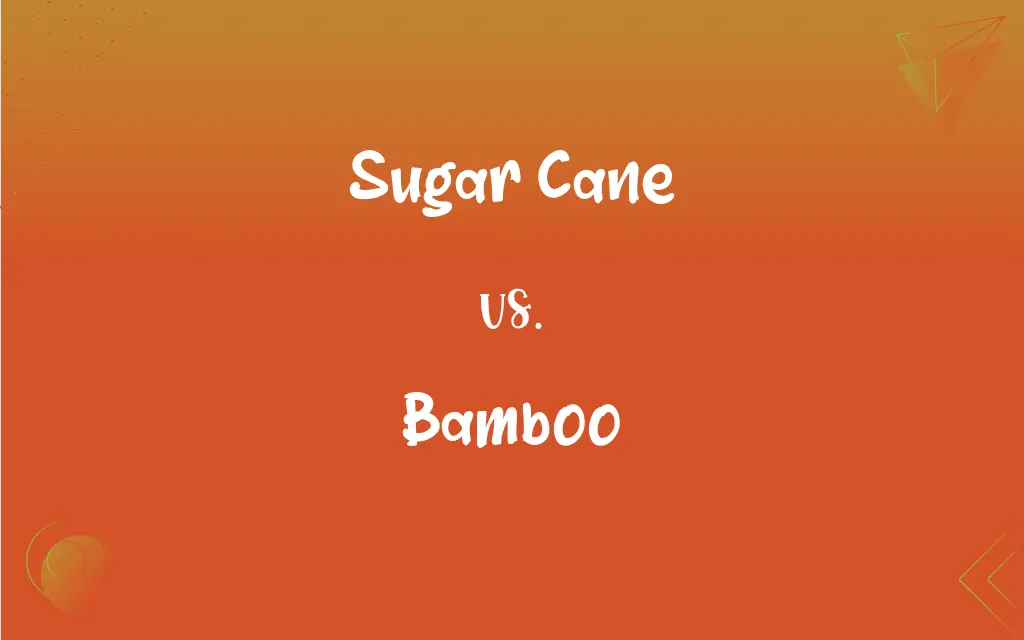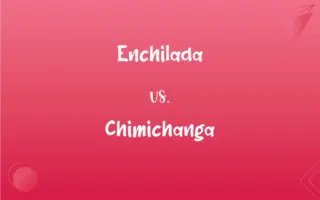Sugar Cane vs. Bamboo: What's the Difference?
By Aimie Carlson & Harlon Moss || Updated on August 18, 2024
Sugar cane is a tropical grass cultivated for its sweet sap, a primary source of sugar, while bamboo is a fast-growing grass used for construction, furniture, and textiles, notable for its hard, woody stems.

Key Differences
Sugar cane and bamboo, despite both being grasses, serve vastly different purposes due to their unique characteristics. Sugar cane is primarily grown in tropical regions for its high sugar content, harvested from the plant's stalks. The sap extracted is a key ingredient in the production of sugar, molasses, and even ethanol, making it crucial to the food and energy sectors. Bamboo, on the other hand, is celebrated for its strong, flexible, and fast-growing stems, making it a popular material in construction, furniture making, and textiles, especially in Asian cultures.
The cultivation requirements for sugar cane and bamboo differ significantly. Sugar cane requires a warm, moist climate to thrive, with a growth cycle that leads to harvesting typically between 10 to 24 months after planting. Bamboo can grow in a variety of climates, from cold mountains to hot tropical regions, with some species capable of growing up to 91 cm (35 in.) in just 24 hours. This rapid growth makes bamboo a highly renewable resource compared to slow-growing trees.
In terms of environmental impact, both plants offer benefits but in different contexts. Sugar cane's cultivation can lead to biodiversity loss and water usage concerns when not managed sustainably. Bamboo, however, is often touted for its environmental benefits, including carbon sequestration, soil stabilization, and its status as a renewable resource due to its fast growth rate.
On a commercial level, sugar cane's economic importance primarily lies in its contribution to the global sugar market and biofuel production. Bamboo's economic role is diverse, spanning construction materials, furniture, household goods, and even clothing, offering a sustainable alternative to wood and other materials.
Culturally, sugar cane has a historical significance in regions like the Caribbean, Brazil, and India, where it has been a staple crop for centuries. Bamboo holds cultural importance in East Asia, symbolizing strength and flexibility, and is integral to traditional architecture, crafts, and even cuisine.
ADVERTISEMENT
Comparison Chart
Primary Use
Production of sugar and ethanol
Construction, furniture, textiles
Growth Environment
Tropical climates
Varied climates, from cold to tropical
Harvest Time
10 to 24 months after planting
Can be harvested in 3 to 5 years
Environmental Impact
Concerns over biodiversity and water usage
Carbon sequestration, soil stabilization
Economic Importance
Sugar and biofuel industries
Construction, furniture, sustainable goods
ADVERTISEMENT
Cultural Significance
Staple crop in Caribbean, Brazil, India
Symbolism and utility in East Asian cultures
Sugar Cane and Bamboo Definitions
Sugar Cane
Ethanol production.
Ethanol for fuel is often derived from sugar cane.
Bamboo
Textile source.
Bamboo fibers are processed into soft, eco-friendly fabrics.
Sugar Cane
Tropical crop.
Sugar cane thrives in the warm climates of Brazil and India.
Bamboo
Renewable resource.
Bamboo's rapid growth makes it a sustainable choice.
Sugar Cane
Culinary uses.
Chopped sugar cane is chewed for its sweet juice in many cultures.
Bamboo
Construction material.
Bamboo is used for scaffolding and building in Asia.
Sugar Cane
Sweet sap source.
Sugar cane's sap is processed to make table sugar and molasses.
Bamboo
Cultural icon.
Bamboo symbolizes resilience and integrity in Chinese culture.
Sugar Cane
Harvest cycle.
The sugar cane harvest cycle necessitates replanting every few years.
Bamboo
Culinary uses.
Young bamboo shoots are a delicacy in Asian cuisine.
Sugar Cane
Alternative spelling of sugar cane
Bamboo
Any of various usually woody, temperate or tropical plants chiefly of the genera Arundinaria, Bambusa, Dendrocalamus, Phyllostachys, or Sasa in the grass family. Certain species of bamboo can reach heights of 20 to 30 meters (66 to 98 feet).
Bamboo
The hard or woody, jointed, often hollow stems of these plants, used in construction and to make various kinds of utensils.
FAQs
Are sugar cane and bamboo used in the food industry?
Sugar cane is a key sugar source, and bamboo shoots are used in cuisine, highlighting their diverse applications in the food industry.
What distinguishes sugar cane from bamboo?
Sugar cane is cultivated for its sweet sap, essential in sugar production, while bamboo is valued for its strong, versatile stems in construction and textiles.
Can sugar cane and bamboo grow in the same environment?
While both prefer warm climates, sugar cane requires more specific tropical conditions, whereas bamboo can adapt to a broader range of climates.
How do sugar cane and bamboo contribute to sustainability?
Sugar cane faces sustainability challenges related to water and land use, while bamboo is considered a highly sustainable resource due to its fast growth and positive environmental impact.
What technological advances are being made with bamboo and sugar cane?
Innovations include biofuels and bioplastics from sugar cane, and engineered bamboo for high-strength building materials and eco-friendly fabrics.
What challenges do sugar cane and bamboo face in terms of global trade?
Sugar cane's global trade is influenced by tariffs and subsidies, affecting market dynamics. Bamboo faces challenges in standardization and quality control, critical for wider acceptance in global markets.
Can sugar cane and bamboo be grown organically?
Both sugar cane and bamboo can be cultivated organically, with practices aimed at minimizing chemical inputs, enhancing soil health, and promoting biodiversity. Organic cultivation is especially appealing for bamboo used in food products and textiles, appealing to eco-conscious consumers.
How do the growth rates of sugar cane and bamboo compare?
Bamboo is one of the fastest-growing plants in the world, significantly outpacing the growth rate of sugar cane, making it a more rapidly renewable resource.
What are the environmental impacts of growing sugar cane versus bamboo?
Sugar cane cultivation can contribute to deforestation and water scarcity, whereas bamboo is often lauded for its environmental benefits, such as improving soil quality and absorbing carbon dioxide.
What are the economic implications of sugar cane and bamboo cultivation?
Sugar cane is vital for the sugar and ethanol industries, with significant global trade implications. Bamboo supports a range of industries from construction to textiles, offering sustainable alternatives to traditional materials.
In what ways are sugar cane and bamboo part of cultural traditions?
Sugar cane has historical significance in sugar-producing regions, often associated with festivals and traditional sweets. Bamboo is deeply embedded in East Asian culture, symbolizing strength and used in traditional art, construction, and everyday objects.
What are the health benefits of sugar cane and bamboo?
Sugar cane juice is rich in antioxidants and has hydrating properties, while bamboo shoots are low in calories, high in dietary fiber, and contain essential nutrients, contributing to digestive health and overall well-being.
How do sugar cane and bamboo cultivation impact local communities?
Sugar cane cultivation is vital for the economies of many developing countries, providing employment and income. Bamboo cultivation supports sustainable development by offering a renewable resource that can be used in various industries, promoting local craftsmanship, and providing alternative income sources.
How are technological advancements transforming the use of sugar cane and bamboo?
Advances include the development of second-generation biofuels from sugar cane waste, enhancing its energy sector role. For bamboo, innovations in processing technologies are enabling its use in high-strength materials for construction, biodegradable plastics, and even in technology components like computer casings and phone covers.
What role do sugar cane and bamboo play in traditional medicine?
In traditional medicine, sugar cane is used for its diuretic and energizing properties, while bamboo has applications in treating infections and promoting healing, showcasing their cultural and health significance beyond their economic uses.
How do sugar cane and bamboo compare in terms of water usage?
Sugar cane requires significant water for irrigation, posing challenges in water-scarce regions. Bamboo, being more drought-resistant, generally requires less water, making it more sustainable in arid and semi-arid areas.
What are the barriers to the global expansion of bamboo products?
Barriers include lack of awareness, limited processing technologies in producing countries, and stringent regulations in export markets. Efforts to standardize quality and promote bamboo's environmental benefits could help overcome these challenges.
How does climate change affect sugar cane and bamboo cultivation?
Climate change poses risks to sugar cane through increased droughts and extreme weather, potentially reducing yields. Bamboo, however, may benefit from increased CO2 levels, enhancing its growth rate, though changes in precipitation patterns could affect specific species differently.
What research is being conducted to improve sugar cane and bamboo sustainability?
Research on sugar cane focuses on improving crop resilience to pests and diseases, enhancing yield, and reducing water usage. For bamboo, efforts include breeding programs for pest resistance, studies on its carbon sequestration capabilities, and developing more efficient processing methods to expand its use in sustainable products.
What future trends are expected for sugar cane and bamboo industries?
The sugar cane industry may see increased emphasis on sustainable practices and biofuel production. For bamboo, trends include growth in the green building sector, innovations in bamboo-based products, and increased global trade as its environmental and sustainable benefits gain wider recognition.
About Author
Written by
Aimie CarlsonAimie Carlson, holding a master's degree in English literature, is a fervent English language enthusiast. She lends her writing talents to Difference Wiki, a prominent website that specializes in comparisons, offering readers insightful analyses that both captivate and inform.
Co-written by
Harlon MossHarlon is a seasoned quality moderator and accomplished content writer for Difference Wiki. An alumnus of the prestigious University of California, he earned his degree in Computer Science. Leveraging his academic background, Harlon brings a meticulous and informed perspective to his work, ensuring content accuracy and excellence.






































































